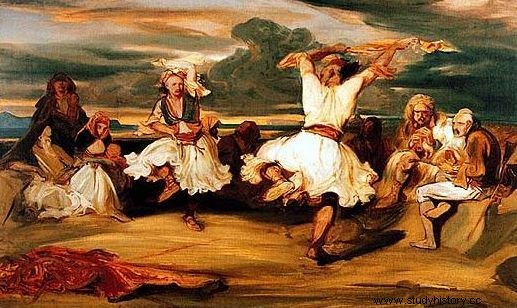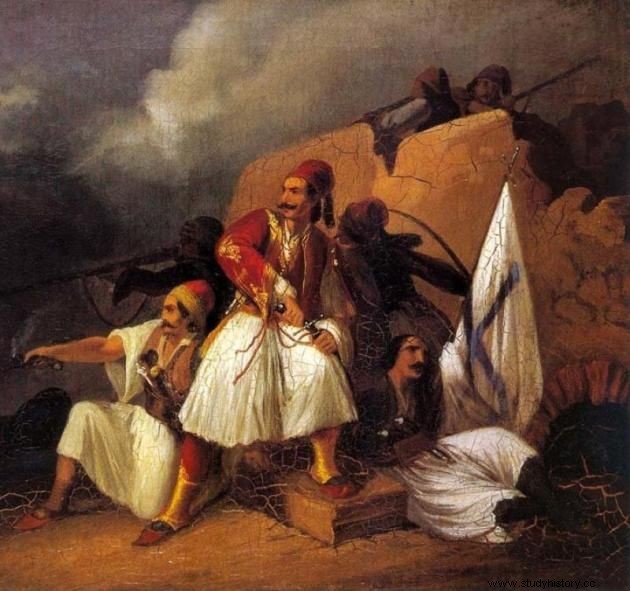May 8, 1821. 120 Greeks led by Odysseus Androutsos stand up, camped inside the Hani of Gravia, against 8,000 Turks of Omer Bryonis and manage to stop them, killing and injuring around 1,000 Turks.
The battle in Alamana was preceded by the crushing defeat of the Greeks which endangered the revolution in Central Greece and the Peloponnese. After his victory, Omer Vryonis intended to go down to the Peloponnese to strike at the heart of the Greek revolution, but first to clear the rebellious areas.
The martyrdom of Athanasios Diakos had left the rebel ragiades without a competent leader. Fear gripped the already revolted centers (Livadia, Salona and Attiki), where the blood of local Turks had been spilled. Everyone expected the merciless fury of the two pasadas to erupt. The Revolution was in serious danger a month after its manifestation and was saved thanks to the military skills of Odysseus Androutsos and the bad calculations of Omer Vryonis.
The facts
Before Omer Bryonis started from Trikala for his campaign against the Peloponnese, he ordered his loyal captains of Western Greece to gather at Gravia Phokidos, from where he would take them with him. To Odysseus Androutsos, he sent a special messenger to announce the end of Athanasios Diakos and to declare to him that if he came to Gravia with the other captains he would not only forgive him for the murder of Hasan bey Geka, but would also give him the chariot of Liakoura.
On May 3, 1821, Odysseas Androutsos arrived in Gravia with Kosmas Souliotis, Efstathios Katsikogiannis and a group of about 100 men. He immediately understood well what the situation was and indicated to the rebels that they had to stop the enemy's march there at any cost.
After they had gathered there at the invitation of Androutsos and other captains, Odysseus Androutsos suggested that they shut themselves up in Hani, so that, unable to retreat, they would be forced to fight at all costs to stop the march of Omer Vryonis.
But neither Panourgias nor Yiannis Diovouniotis accepted. Finally, they were divided into three sections. One, with Panourgias and Dyovouniotis, took the heights of Chlomos, to the left of the road. The other with Kosmas Souliotis and Katsikogiannis, the heights to the right of the road. Those who wanted would close together with Odysseas Androutsos in Hani. In fact, to encourage them more, Androutsos invited his men to dance and pulled the cloth. The first to grab the handkerchief was Yannis Gouras, then Papandrias, Komnas Trakas, Aggelis Govios, the Kapoiorgai and others. A total of one hundred and twenty men were caught up in the dance and within minutes, they had turned Hani into a fortress. They blocked the openings and opened battlements.

The battle
As soon as Omer Vryonis arrived, after displacing the divisions of Panourgias, Dyovouniotis, Souliotis and Katsikogiannis, he realized what was happening inside the Hani and became very angry. After the Turks surrounded the area and Hani, he sent Hasan-dervish to tell Androutsos to surrender. But Androutsos did not accept and the negotiation became abusive, as a result of which the dervish fell dead from Androutsos' bullet. This gave the battle signal.
The Turks attacked the inn, but were repulsed with heavy losses and forced to retreat. Thus the first raid was repulsed, as were the second and third. Bryonis, seeing his men falling from the fire of the Greeks, ordered cannons to be brought in to blow up the building. The Turks halted the attack until the cannon came up, while the Greeks, perceiving their intentions, at night, late towards dawn, after they had succeeded in putting up a gallant resistance and killing over 300 Turks, at the same time delaying the enemy's march , managed to sneak out of Hani by passing between the enemy Turkish lines. The daring exit cost them only 6 dead.

Consequences of the battle
The victims of the Turks were numerous. Over 300 had been killed and 600 injured within hours. The Greeks lost only 6 warriors. The strategic success of this battle was great. He prevented the descent of Omer Bryonis in the Peloponnese and facilitated the victory at Valtetsi which animated the revolution. Specifically, after the battle in Gravia, Bryonis was so shocked that he decided to temporarily stop his campaign and retreat to Evia, to later meet the forces of Kiose Mehmet.
Thus the descent of such a powerful army into the Peloponnese, where the revolution had not yet been established, was prevented, while it contributed to the start of the struggle in western Greece as well.
*Dedicated to the tour guide who works with great zeal at Hani tis Gravia and is a model of hospitality.
